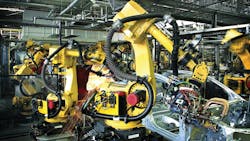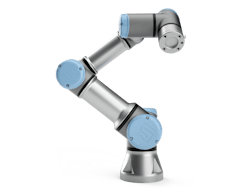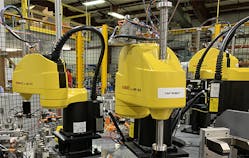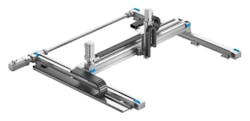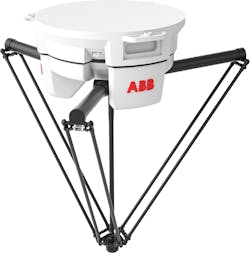With the explosion in robotic technologies that has occurred in the past decade, it’s important to realize there are three categories of robots: industrial, commercial and consumer. Within each category there are different types of robots that target diverse applications.
Cory Roehl, marketing and technical sales engineer at CNC Solutions, described industrial robots as fixed-position machines that work fast and with extreme accuracy. In concept, they are capable of repeating the same tasks perfectly forever. Roehl sees this longevity, paired with the length of time it takes for manufacturers to realize a return on investment (ROI), makes industrial robots desirable for processes that are not likely to change for very long periods of time.
While this is true for many industrial robots, several companies are developing technologies that allow industrial robots to operate collaboratively alongside humans. For example, Veo Robotics with its FreeMove system designed to enable industrial robots to operate collaboratively, and ABB’s combination of industrial and collaborative robot (cobot) technologies in its Swifti robot.
Cobots can work alongside humans with minimal safety devices, following a valid risk assessment, of course. This is possible via the integration of sensors that signal the cobot to slow down or stop when humans draw close. These robots also have lower speed-force capabilities than industrial robots to further ensure their safety.
Although cobots can perform some of the same tasks that traditional industrial robots handle, they cannot support heavier loads due to their lighter weight and size. Additionally, cobots cannot match the speed of their industrial counterparts.
Understanding different robot types
In a post on the Catalyst Connection site, Matt Minner, senior consultant for technical services at Catalyst Connection, a non-profit organization that provides consulting and training services to manufacturers in Pennsylvania, noted how every manufacturer should be clear on the differences among the four major types of robots: articulated, SCARA, delta and cartesian robots.
Minner classified articulated robots in the article by the number of points of rotation or axes they have, the most common being six axes. However, four- and seven-axis versions are also available.
Articulated robots, according to Minner, suit tasks that span non-parallel planes, such as machine tending. They employ sealed joints and protective sleeves, allowing them to operate in both clean and dirty environments alike. Mountable on any surface, articulated robots are viable for a wide range of applications.”
A selective compliance articulated (SCARA) robot arm is a cost-effective option for operations between two parallel planes, for example transferring parts from place to place, according to Minner. SCARA robots are small and lightweight and are capable of very fast cycle times. However, their fixed-swing-arm design limits their use for tasks that require working around or reaching inside objects. Target tasks include pick-and-place, assembly, inspection, packaging and dispensing.
Delta robots, a.k.a., spider robots, rely on three motors to actuate their control arms. Basic delta robots are three-axis models, but four- and six-axis models are available. Minner pointed out that a delta robot’s arm can be very lightweight, allowing for rapid movement and making delta robots viable for high-speed applications with light loads. Typical applications include assembly and inspection.”
However, assembling a custom cartesian system can make design, component specification and programming highly challenging and therefore out of reach for some manufacturers. Additionally, cartesian robots can’t reach into or around obstacles easily and their exposed sliding mechanisms make them unsuitable for deployment in dirty environments. Top applications include pick-and-place, inspection, assembly and dispensing.
Robot selection considerations
Aside from cost, there are several application-specific issues to focus on when selecting industrial robots and/or cobots.
First and foremost, it is important to match the robot to the task. Craig Schlenoff, associate vice president for standardization at IEEE Robotics and Automation Society, explained, “Different robots have different capabilities such as the amount of weight they can lift, how far they can reach and how flexible they are, i.e., their degrees of freedom. It is very important to know what you want to do with the robot before you start exploring what is available.”
Justin Garski, manager of the Americas OEM segment at Rockwell Automation, said, “I almost think cost is the least important thing to consider. With the wave of workforce woes, the traditional ROI calculations are often not part of the discussion.” He considers speed, floor space, the environment, support and durability as top items to focus on. “Cobots are a great tool and are generating mountains of interest in robotics. But the truth is, they aren’t fast and are not as durable as their industrial peers. Where they do shine is potentially not needing as much floor space due to the absence of a cage around them,” he added.
He also views support as possibly being the most important factor for buyers to consider. He said, “Who will maintain the robots? Do you already have 10 robots from brand x? If so, unless you have a great reason to change, stick with what you know. Work with an OEM or system integrator that will have your back when things go bump in the night.”
Garski added, “The biggest difficulty from where I sit is incomplete specifications or expectations from the end user. Robot and machine builders are only as good as the info they receive. Finding a good partner that knows the right questions to ask will help avoid a lot of headaches later.”
Robot use in processing applications appears to be slim, and there are some viable reasons for that. According to Matt Ruth, president of Avanceon, “We don’t see a lot of use, if any, of robots in the batch nor continuous process areas. I believe it’s because the repetitive tasks in batch are often ingredient additions and by automating those, a manufacturer will invest in an ingredient delivery system, like pneumatic- and/or gravity-based weigh scales. As a result, robots don’t fit well.”
Ruth added, “Most robot use is traditionally on an assembly or packaging line such as palletizing. I haven’t seen breakthrough technology to justify their use in upstream areas of the manufacturing plant.”
The key to successful robot implementations
According to Columbia/Okura, an integrator that focuses on robotic palletizing systems, converting a manual process to automation requires the services of an integrator. Robotic integrators offer expertise and experience in creating, installing and maintaining robotic systems and are responsible for ensuring the system runs without a hitch.
The robotics marketing team at the Association for Advancing Automation (A3) concur. They claim, “Nearly every time a manual process is automated or when older robotic systems are being replaced, a robot integrator is necessary.”
Columbia/Okura and A3 offered several steps for choosing the right integrator. These include:
- Choose an integrator with years of experience who can leverage product knowledge and past project experience.
- Select an integrator that can provide drawings and time studies employing 3D simulations to demonstrate how the robot(s) will function.
- Choose an integrator that offers preventative maintenance programs beyond system installation.
- To achieve the maximum ROI, employ an integrator that understands productivity needs during and after the installation.
